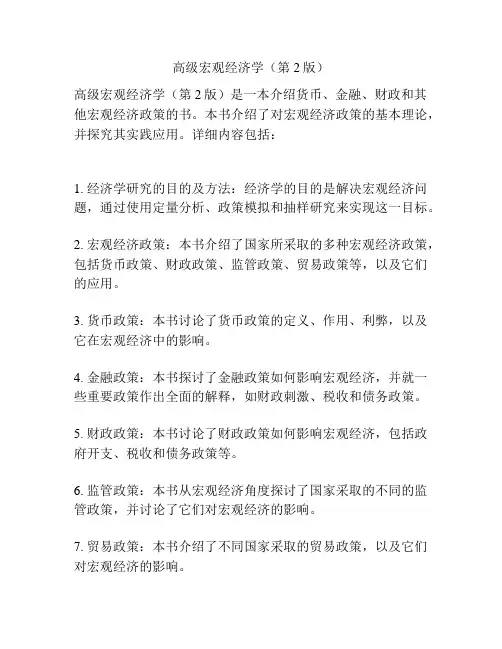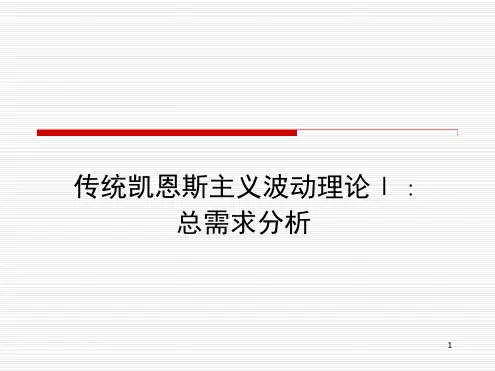《高级宏观经济学(2)》课件-1
- 格式:pdf
- 大小:44.14 KB
- 文档页数:6

高级宏观经济学第二讲课程体系01 宏观经济学分析框架与索洛增长模型02无限期界与世代交叠模型03新增长理论04RBC模型不完全名义调整的微观基础•与索洛模型相似:•本章的这两个模型依旧把劳动与知识当作外生的。
•与索洛模型不同:•模型从竞争性市场的最大化家庭与厂商的相互作用中引出资本存量的演化,因而,储蓄不再是外生的。
•在这两个模型中,经济总量的动态学由微观层次的决策决定。
θρg t r t c t c −−=)()()( θρ−=)()()(t r t C t C 3、家庭最优化家庭在预算约束限制下,选择消费的路径来最大化其终身效用(通过构造拉格朗日函数计算)。
每单位有效劳动消费的最优增长率: 每个工人的消费C(t)等于A(t)c(t),其增长率为: 欧拉方程 该式意味着,如果实际报酬超过了家庭用于贴现未来消费的速率,每个工人的消费将上升。
三、经济的动态学θθρg t r t c t c −−=)()()( )()()())(()(t k g n t c t k f t k+−−= 消费的动态学 资本的动态学k=k k* c 与k 的动态学:系统是鞍点路径稳定k*小于资本的黄金律水平:由ρ-n-(1-θ)g>0得到:ρ+θg >n+g稳定臂 要求:推导相位图和上述结论。
非稳定臂稳态 k G c*四、平衡增长路径•经济行为一旦收敛于稳态点,它就等同于处于平衡增长路径上的索洛经济的行为。
•每单位有效劳动的资本、产出与消费不变;总量以n+g的速率增长;每工人产出、资本与消费以g的速率增长。
•索洛模型与拉姆齐-凯斯-库普曼斯模型的平衡增长路径之间的惟一显著的差异是,在后者不可能出现动态无效率。
五、贴现率下降k c E E’ =0=kρ下降与索洛模型中的储蓄率上升相似。
c在冲击时刻发生向下跳跃,然后与k一起逐渐上升到其初始水平之上。
与索洛模型不k*。


高级宏观经济学(第2版)
高级宏观经济学(第2版)是一本介绍货币、金融、财政和其他宏观经济政策的书。
本书介绍了对宏观经济政策的基本理论,并探究其实践应用。
详细内容包括:
1. 经济学研究的目的及方法:经济学的目的是解决宏观经济问题,通过使用定量分析、政策模拟和抽样研究来实现这一目标。
2. 宏观经济政策:本书介绍了国家所采取的多种宏观经济政策,包括货币政策、财政政策、监管政策、贸易政策等,以及它们的应用。
3. 货币政策:本书讨论了货币政策的定义、作用、利弊,以及它在宏观经济中的影响。
4. 金融政策:本书探讨了金融政策如何影响宏观经济,并就一些重要政策作出全面的解释,如财政刺激、税收和债务政策。
5. 财政政策:本书讨论了财政政策如何影响宏观经济,包括政府开支、税收和债务政策等。
6. 监管政策:本书从宏观经济角度探讨了国家采取的不同的监管政策,并讨论了它们对宏观经济的影响。
7. 贸易政策:本书介绍了不同国家采取的贸易政策,以及它们对宏观经济的影响。
8. 社会政策:本书探讨了社会政策如何影响宏观经济,包括福利政策、就业政策、教育政策和社会保障政策等。
高级宏观经济学(第2版)提供了宏观经济政策的重要知识,对于理解国家如何平衡经济增长和稳定性至关重要。
它包括了一系列基础理论,以及一些实际参考例子,包括非洲,拉丁美洲,南亚,亚洲和其他地区的案例研究。
本书是经济学家和公共政策研究者的必读之作,是学习和研究宏观经济政策的基础工具。



![高级宏观经济学[2]](https://uimg.taocdn.com/84a318955122aaea998fcc22bcd126fff7055d0d.webp)




罗默《高级宏观经济学》课件罗默的《高级宏观经济学》课件一、引言罗默的《高级宏观经济学》是一本在学术界广受推崇的经济学教材,深入浅出地介绍了宏观经济学的基本理论和分析方法。
本书共分为两个部分,第一部分主要讨论宏观经济学的微观基础,包括消费者行为、生产者行为、市场均衡和一般均衡等;第二部分则重点介绍宏观经济学的核心议题,如经济增长、失业、通货膨胀、经济周期等。
本课件旨在帮助读者更好地理解和掌握罗默的《高级宏观经济学》的内容,为宏观经济学的学习和研究提供有益的参考。
二、微观基础1.消费者行为罗默认为,消费者行为是宏观经济学微观基础的重要组成部分。
消费者的目标是实现效用最大化,即在预算约束下,选择一组商品和服务,使得总效用达到最大。
为此,罗默介绍了无差异曲线、预算线等概念,以及如何通过求解拉格朗日函数来找到消费者最优消费组合的方法。
2.生产者行为生产者行为是宏观经济学微观基础的另一个重要组成部分。
罗默认为,生产者的目标是实现利润最大化,即在生产技术、要素价格和市场价格的约束下,选择一组生产要素和产量,使得总利润达到最大。
罗默详细介绍了生产函数、成本函数、利润函数等概念,以及如何通过求解拉格朗日函数来找到生产者最优生产组合的方法。
3.市场均衡和一般均衡罗默认为,市场均衡是宏观经济学的核心概念之一。
市场均衡指的是在某一市场价格下,市场需求等于市场供给。
罗默介绍了如何通过供求曲线来分析市场均衡,以及市场均衡的稳定性条件。
罗默还介绍了一般均衡理论,即在一个包含多个市场和多种商品的体系中,各个市场之间相互影响,形成一个稳定的均衡状态。
三、核心议题1.经济增长罗默认为,经济增长是宏观经济学研究的核心议题之一。
经济增长指的是一个国家或地区在一定时期内,实际产出水平持续提高的过程。
罗默详细介绍了经济增长的源泉,包括技术进步、资本积累、劳动力增长等,并分析了不同增长模型的特点和适用条件。
2.失业罗默认为,失业是宏观经济学的另一个核心议题。
Xiamen University Fall 2006ADVANCED MACROECONOMICS IICourse DescriptionThe objective of this course is to introduce the students to major issues, some very useful analytical tools and recent advances in modern macroeconomics. Topics include growth theory, business cycle theory, inflation, unemployment and macroeconomic policy.Course EvaluationAssignments: 30%Final Exam: 70%Course OutlineI.Introduction (and Review of Intermediate Macroeconomics)II.Mathematical Tools (Dynamic Optimization)III.Economic GrowthIV.Economic FluctuationsV.Inflation and Monetary PolicyVI.Unemployment and Coordination FailureReading MaterialsThe readings are drawn from scholarly journals in economics and the following textbooks:1.Aghion, P. and P. Howitt, Endogenous Growth Theory, MIT Press, 1998.2.Barro, R. and X. Sala-i-Martin, Economic Growth, McGraw-Hill, 1995.3.Blanchard, O. and S. Fischer, Lectures on Macroeconomics, MIT Press, 1989.4.Chang, A. C., Elements of Dynamic Optimization, McGraw-Hill, 1992.5.Sargent, T., Dynamic Macroeconomic Theory, Harvard University Press, 1987.6.Mankiw, N. G. and D. Romer (eds.), New Keynesian Economics, MIT Press,1991.7.Romer, D., Advanced Macroeconomics, McGraw-Hill, 2001.Reading ListI.Introduction (and Review of Intermediate Macroeconomics)Abel, A. B. and B. S. Bernanke, Macroeconomics, 5th edition,Addison-Wesley, 2005.Romer, Chapter 5Mankiw and Romer, Volume 1, IntroductionMankiw, N. Gregory, “A Quick Refresher Course inMacroeconomics,” Journal of Economic Literature (1990): 1645-60.Blanchard, Olivier, “What Do We Know about Macroeconomics That Fisher and Wicksell Did Not?” Quarterly Journal of Economics(2000): 1375-1409.II.Mathematical Tools (Dynamic Optimization)Lecture NotesChiang, Alpha C. Elements of Dynamic Optimization, McGraw-Hill, Inc., 1992.Kamien, Morton I. and Nancy L. Schwartz. Dynamic Optimization: The Calculus of Variations and Optimal Control in Economics andManagement, 2nd edition, Elsevier, New York, 1991.Sargent, Thomas J. Dynamic Macroeconomic Theory, HarvardUniversity Press, 1987.III.Economic GrowthA. IntroductionBarro and Sala-i-Martin, Introduction.Aghion and Howitt, Introduction and Chapter 1.B. Neoclassical Growth: Solow ModelBarro and Sala-i-Martin, Chapter 1.Romer, Chapter 1.Solow, Robert. “A Contribution to the Theory of Economic Growth,”Quarterly Journal of Economics 70 (1956): 65-94.Phelps, E. “The Golden Rule of Accumulation: A Fable forGrowthman,” American Economic Review 51 (1961):638-43.C. Neoclassical Growth: Ramsey-Cass-Koopmans ModelBarro and Sala-i-Martin, Chapter 2.Romer, Chapter 2.Cass, D. “Optimal Growth in an Aggregate Model of CapitalAccumulation,” Review of Economic Studies 32 (1965), 233-40.Koopmans, T. “On the Concept of Optimal Economic Growth,” in The Econometric Approach to Development Planning, Amsterdam,North Holland, 1965.Ramsey, F. “A Mathematical Theory of Saving,” Economic Journal38 (1928): 543-59.D. Endogenous Growth: Capital-Based ModelsBarro and Sala-i-Martin, Chapters 4 and 5Romer, P. “Increasing Returns and Long-Run Growth,” Journal of Political Economy 94 (1986): 1002-37.Lucas, R.E., Jr. “On the Mechanics of Economic Development,”Journal of Monetary Economics 22 (1988): 3-42.Rebelo, S. “ Long-Run Policy Analysis and Long-Run Growth,”Journal of Political Economy 99 (1991): 500-21.E.Endogenous Growth: Innovation-Based Models with VarietyExpansionBarro and Sala-i-Martin, Chapter 6.Romer, P. “Endogenous Technological Change,” Journal of Political Economy 98 (1990): S71-S102.Gancia, G. and F. Zilibotti. “Horizontal Innovation in the Theory of Growth and Development,” in Handbook of Economic Growth, North Holland 2005.F.Endogenous Growth: Innovation-Based Models with QualityImprovementsBarro and Sala-i-Martin, Chapter 7.Aghion and Howitt, Chapter 2.Aghion, P. and P. Howitt. “A Model of Growth through Creative Destruction,” Econometrica 60 (1992): 323-51.Aghion, P. and P. Howitt. “Growth with Quality-Improving Innovations: An Integrated Framework,” in Handbook of EconomicGrowth, North Holland 2005.Aghion, P. and P. Howitt. “Appropriate Growth Policy: A Unifying Framework,” Working Paper, 2005.G. Endogenous Growth in Open EconomiesGrossman, G.M. and E. Helpman. “Comparative Advantage and Long-Run Growth,” American Economic Review 80 (1990): 796-815. Grossman, G.M. and E. Helpman. “Quality Ladders and Product Cycles,” Quarterly Journal of Economics 106 (1991): 557-586.Howitt, P. “Endogenous Growth and Cross-Country Income Differences,” American Economic Review 90 (2000): 829-46.Howitt, P. and D. Mayer-Foulkes. “R&D, Implementation and Stagnation: A Schumpeterian Theory of Convergence Clubs,”Journal of Money, Credit and Banking 37 (February 2005): 147-77. Aghion, P., P. Howitt and D. Mayer-Foulkes. “The Effect of Financial Development on Convergence: Theory and Evidence,”Quarterly Journal of Economics 120 (2005): 173-222.Daron, A., P. Aghion and F. Zilibotti. “Distance to Frontier, Selection and Economic Growth.” The Journal of the EuropeanEconomic Association (2006), forthcoming.H. Endogenous Growth, Competition and FinanceAghion and Howitt, Chapter 7.Aghion, P. and P. Howitt. “Growth with Quality-Improving Innovations: An Integrated Framework,” in Handbook of Economic Growth, North Holland 2005.Helpman, E. “Innovation, Imitation and Intellectual Property Rights,”Econometrica 68 (2001): 467-92.Aghion, P, N. Bloom, R. Blundell, R. Griffith and P. Howitt.“Competition and Innovation: An Inverted-U Relationship,”Quarterly Journal of Economics 120 (May 2005): 701-28.Aghion, P., C. Harris, P. Howitt and J. Vickers. “Competition, Imitation and Growth with Step-by-Step Innovation,” Review ofEconomic Studies 68 (2001): 467-92.Aghion, P., P. Howitt and D. Mayer-Foulkes. “The Effect of Financial Development on Convergence: Theory and Evidence,”Quarterly Journal of Economics 120 (2005): 173-222.Aghion, P., D. Comin and P. Howitt. “When Does Domestic Saving Matter for Economic Growth?” Working paper (2006).I. Sources of GrowthBarro and Sala-i-Martin, Chapters 10 and 12.Easerly, W. and R. Levine. “It’s Not Factor Accumulation: Stylized Facts and Growth Models,” World Bank Economic Review 15(2)(2001): 177-219.Barro, R. “Human Capital and Growth,” American Economic Review91 (2001): 12-17.Sachs, J.D. and A.M. Warner. “Fundamental Sources of Long-Run Growth,” American Economic Review 87 (1997): 184-188.Sala-i-Martin, X. “I Just Run Two Millions Regressions,” American Economic Review 87 (1997): 178-182.Caselli, F. “The Missing Input: Accounting for Cross-Country Income Differences,” in Handbook of Economic Growth, NorthHolland 2005.J. Testing for Endogenous GrowthAghion and Howitt, Chapters 8 (Section 5) and 12.Jones, C. “R&D-Based Models of Economic Growth,” Journal of Political Economy 103 (1995): 759-84.Jones, C. “Time Series Tests of Endogenous Growth Models,”Quarterly Journal of Economics 110 (1995): 495-525.Howitt, P. “Steady Endogenous Growth with Population and R&D Inputs Growing,” Journal of Political Economy 107 (1999): 715-30. Mankiw, N.G., D. Romer and D. Weil. “A Contribution to the Empirics of Economic Growth,” Quarterly Journal of Economics 107 (1992): 407-37.Evans, P. “Using Cross-Country Variances to Evaluate Growth Theories,” Journal of Economic Dynamics and Control 20 (1996):1027-49.IV.Economic FluctuationsA. Stylized Facts of Business CyclesAbel and Bernanke, Chapter 8 (Sections 2 and 3).Romer, Chapters 1 (Sections 1 and 2) and 5 (Section 6).B. Real Business Cycle (RBC) TheoryKydland, F. and E. C. Prescott. “Time to Build and Aggregate Fluctuations,” Econometrica 50 (1982): 1345-70.Long, J. and C. Plosser. “Real Business Cycles,” Journal of Political Economy 91 (1989):39-69.Mankiw, N. G. “Real Business Cycles: A New KeynesianPerspective,” Journal of Economic Perspective 3 (1989): 79-90.King, R. and S. Rebelo. “Resuscitating Real Business Cycles,” in Handbook of Macroeconomics, 1999 (Chapter 14).Gomme, P., F. Kydland and P. Rupert. “Home Production Meets Time to Build,” Journal of Political Economy 109 (2001): 1115-31.Rebelo, S. “Real Business Cycle Models: Past, Present and Future,”Scandinavian Journal of Economics 107(2005): 217-38.C. (New) Keynesian TheoryRomer, Chapters 5 and 6 (Parts B and C)Blanchard and Fischer, Chapters 8 and 10Fischer, S. “Long-Term Contracts, Rational Expectations, and the Optimal Money Rule,” Journal of Political Economy 85 (1977): 191-205.Taylor, J. “Staggered Wage Setting in a Macro Model,” American Economic Review 69 (1979): 108-113.Taylor, J. “Staggered Price and Wage Setting in Macroeconomics,”in Handbook of Macroeconomics, 1999 (Chapter 15).Mankiw, N. G. “Small Menu Costs and Large Business Cycles: A Macroeconomic Model of Monopoly,” Quarterly Journal ofEconomics 100 (1985): 529-39.Ball, L., N. G. Mankiw and D. Romer. “The New KeynesianEconomics and the Output-Inflation Trade-off,” Brookings Papers onEconomic Activity 1 (1988): 1-65.Ball, L and D. Romer. “ Real Rigidities and the Non-Neutrality of Money,” Review of Economic Studies 57 (1990): 183-302.V.Inflation and Monetary PolicyRomer, Chapter 9Blanchard and Fischer, Chapters 4, 5 and 11.Samuelson, P. A. “An Exact Consumption-Loan Model of Interest With or Without the Social Contrivance of Money,” Journal ofPolitical Economy 66 (1958): 1002-11.Diamond, P. A. “National Debt in a Neoclassical Growth Model,”American Economic Review 55 (1965): 1126-50.Kiyotaki, N. and R. Wright. “A Search-Theoretic Approach toMonetary Economics,” American Economic Review 83 (1993): 63-77.Howitt, P. “Beyond Search: Fiat Money in Organized Exchange,”International Economic Review 46 (2005): 405-29.Clarida, R., J. Gali and M. Gertler. “The Science of Monetary Policy:A New Keynesian Perspective,” Journal of Economic Literature 37(1999): 1661-1707.Kydland, F. and E. Prescott. “Rules Rather Than Discretion: The Inconsistency of Optimal Plans,” Journal of Political Economy 85(1977): 473-91.Lucas, R. E. “Econometric Policy Evaluation: A Critique,” Carnegie-Rochester Conference Series on Public Policy 1 (1976): 19-46.Blanchard, O. and J. Gali. “Real Wage Rigidities and the NewKeynesian Model,” Federal Reserve Bank of Boston Working Paper(2005), No. 05-14.McCallum, B. “Issues in the Design of Monetary Policy Rules,” in Handbook of Macroeconomics, 1999 (Chapter 23).VI.Unemployment and Coordination FailureRomer, Chapter 10Blanchard and Fischer, Chapter 9 (Section 5).Pissarides, C. A., Equilibrium Unemployment Theory, Blackwell, 1990 (Part I).Shapiro, C. and J. E. Stiglitz. “Equilibrium Unemployment as a Worker-Discipline Device,” American Economic Review 74 (1984):433-44.Diamond, P. “Aggregate-Demand Management in SearchEquilibrium.” Journal of Political Economy 90 (1982): 881-94.Cooper, R. and A. John. “Coordinating Coordination Failures in Keynesian Models,” Quarterly Journal of Economics 103 (1988):441-63.。